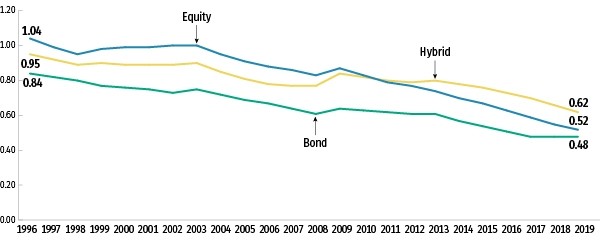Expense Ratios of Actively Managed and Index Funds Have Declined for More Than Two Decades
Washington, DC; March 26, 2020—The average expense ratios of equity, hybrid, and bond mutual funds—including both actively managed and index equity and bond mutual funds—have declined substantially over a period of more than 20 years, according to a new research report from the Investment Company Institute (ICI).
The report, “Trends in the Expenses and Fees of Funds, 2019,” found that equity mutual fund expense ratios averaged 0.52 percent in 2019 compared with 1.04 percent in 1996—a 50 percent decrease. Hybrid mutual fund expense ratios averaged 0.95 percent in 1996 and fell to 0.62 in 2019; and similarly, bond mutual fund expense ratios averaged 0.84 percent in 1996, falling to 0.48 percent in 2019. These figures are asset-weighted averages, which better reflect the expenses that shareholders actually pay through funds.
“Investors’ increasing use of lower-cost funds and fund share classes has contributed to the trend of declining average expense ratios,” said Shelly Antoniewicz, ICI’s senior director of industry and financial analysis. “As the fund industry continues to meet the demands and needs of cost-conscious investors, competition pushes down the expense ratios of mutual funds and exchange-traded funds (ETFs).”
Average Expense Ratios for Long-Term Mutual Funds Have Fallen
Percent

Note: Expense ratios are measured as asset-weighted averages.
Sources: Investment Company Institute, Lipper, and Morningstar
Expense Ratios for Actively Managed Mutual Funds Continued to Decrease in 2019
ICI’s report shows that asset-weighted average expense ratios for both actively managed and index equity and bond mutual funds have fallen from their levels in 1996. In 2019, the average expense ratio of actively managed equity mutual funds was 0.74 percent, compared with 1.08 percent in 1996. Similarly, average index equity mutual fund expense ratios were 0.07 percent in 2019, compared with 0.27 percent in 1996. This trend is fueled by investor interest in lower-cost actively managed and index equity mutual funds, as well as asset growth and the resulting economies of scale.
Actively managed and index bond mutual funds have also seen a decline in average expense ratios over the same period. Between 1996 and 2019, the average expense ratio for actively managed bond mutual funds fell from 0.84 percent to 0.56 percent. The average expense ratio for index bond mutual funds fell from 0.20 percent in 1996 to 0.07 percent in 2019 (see Figure 13 in the report).
Inflows to Actively Managed and Index Funds Are Concentrated in Lower-Cost Funds
Fund investors continued to favor lower-cost funds in 2019, according to the report. For example, the report shows that only actively managed world equity funds with expense ratios among the lowest 5 percent saw inflows in 2019. Among actively managed bond and hybrid funds, those with expense ratios in the lowest quartile saw inflows, which were most concentrated among funds with expense ratios in the lowest 5 percent. Among index funds—including domestic equity funds, world equity funds, and bond and hybrid funds—those with expense ratios in the lowest quartile all received inflows (see Figure 18 in the report).
Index ETF Expense Ratios Declined in 2019
ETFs are generally index-based and typically do not bundle distribution, account servicing, or maintenance fees in their expense ratios. Because of this, their expense ratios tend to be low. According to the report, the asset-weighted average expense ratio of index equity ETFs fell by 1 basis point between 2018 and 2019, to 0.18 percent. Average index bond ETF expense ratios also declined by 1 basis point, to 0.14 percent (see Figure 16 in the report).
Data for all figures in the report are accessible here.
